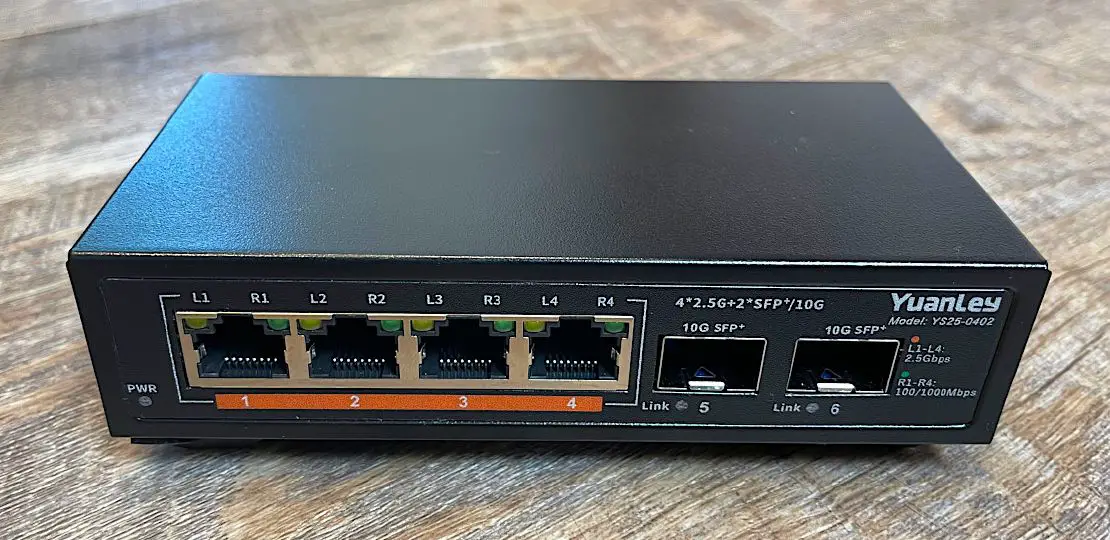YuanLey 2.5 GbE / 10G SFP+ Unmanaged Network Switch
Table of Contents
At the time of this writing, I have been working to build out a lab network to help me more easily test various network configurations using mini-PCs, network switches, and wireless access points. I decided that I needed to purchase a small, unmanaged network switch with higher speed network interfaces. With the faster interfaces, I can test network throughput across multiple devices without needing to directly connect them together.
For the lab network, I am using one of the network interfaces on my OPNsense system that is not being used by main network to create a dedicated network. The unmanaged switch is connected to that interface which allows me to connect multiple 2.5/10G devices into the lab network.
My thought process is that I could run multiple mini-PCs with OPNsense to try different network configurations at the same time so I do not have to tear down those networks in the lab if I am working on something new or on something that will take a while to complete. So basically I could run multiple networks behind the unmanaged switch that is on my lab network (my lab network would essentially provide the “WAN” connection for each network behind the mini-PCs I am testing).
Because I do not need a managed switch for the lab network based on how I intend to use it, that opens up more budget friendly unmanaged switch options. Serve the Home has reviewed a ton of budget friendly options that exist on Aliexpress (affiliate link) . Many of the most budget friendly options hovered between $80-100 USD.
However, for the fun of it, I decided to check Amazon (affiliate link) . I discovered two network switches, JuanLey (affiliate link) and VIMIN (affiliate link) , that had four 2.5G Ethernet interfaces and two 10G SFP+ interfaces that were $69.99 with a 10% off coupon, which made the switches $62.99 USD. They appeared to be made by the same manufacturer but had different brand names. The price was appealing enough that I decided to go for it even though I had considered other brand name alternatives such as the QNAP QSW-2104-2T-A-US switch or the SFP+ version of the QNAP switch (affiliate link) .
Note
Full disclosure: The YuanLey switch was not sponsored. I purchased this switch with my own funds. I thought it may be helpful to provide a review for those who are curious how well a budget friendly 2.5/10G unmanaged switch would perform.
Unboxing
When you unbox the switch, you get the switch itself and the power cord. There is nothing fancy about the packaging or the contents of the box, but that is to be expected at the low end of the budget spectrum.
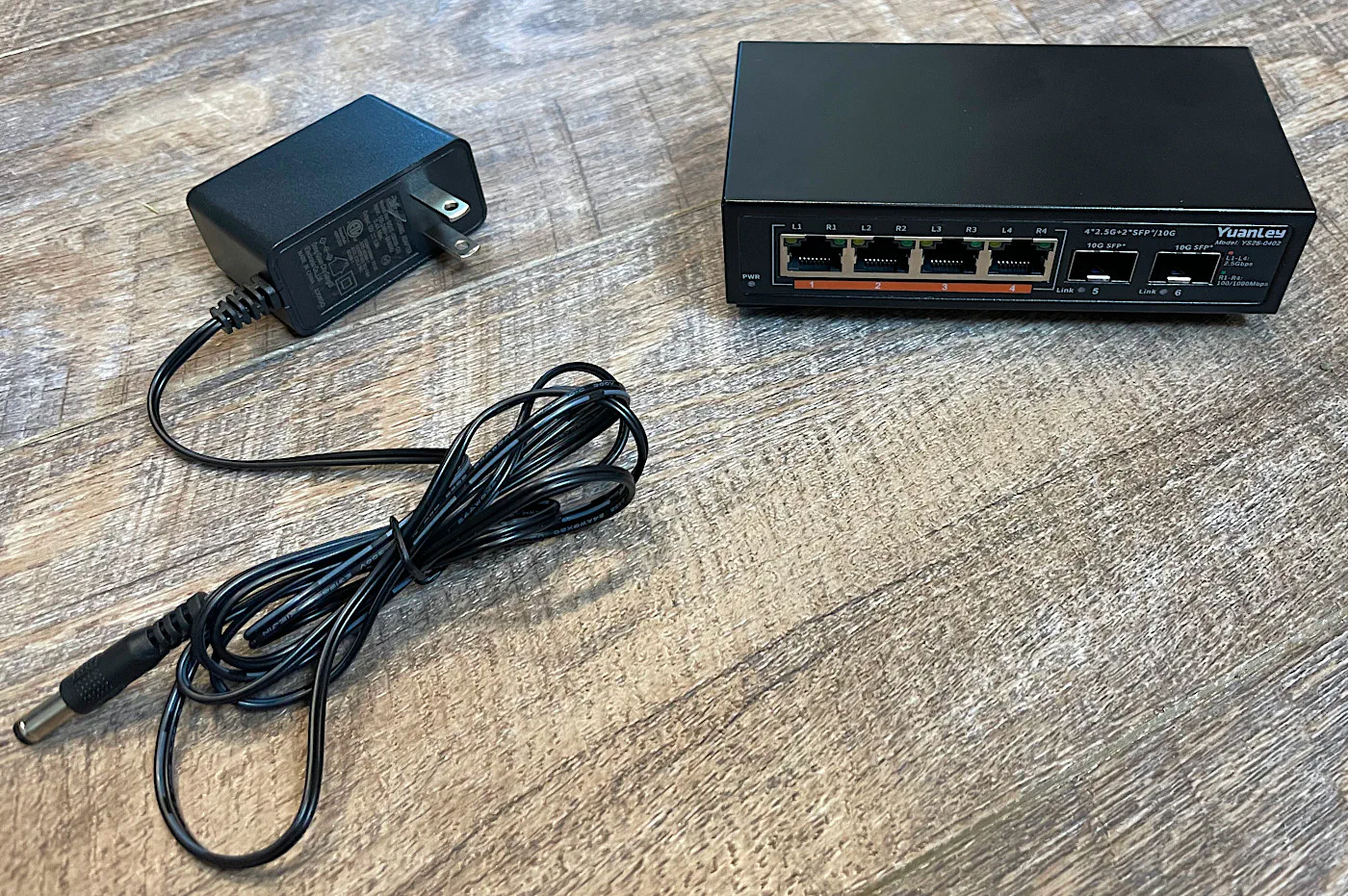
On the back you will see where the power plugs in as well as a grounding screw which is nice if you wish to ground your switch since the case is metal.
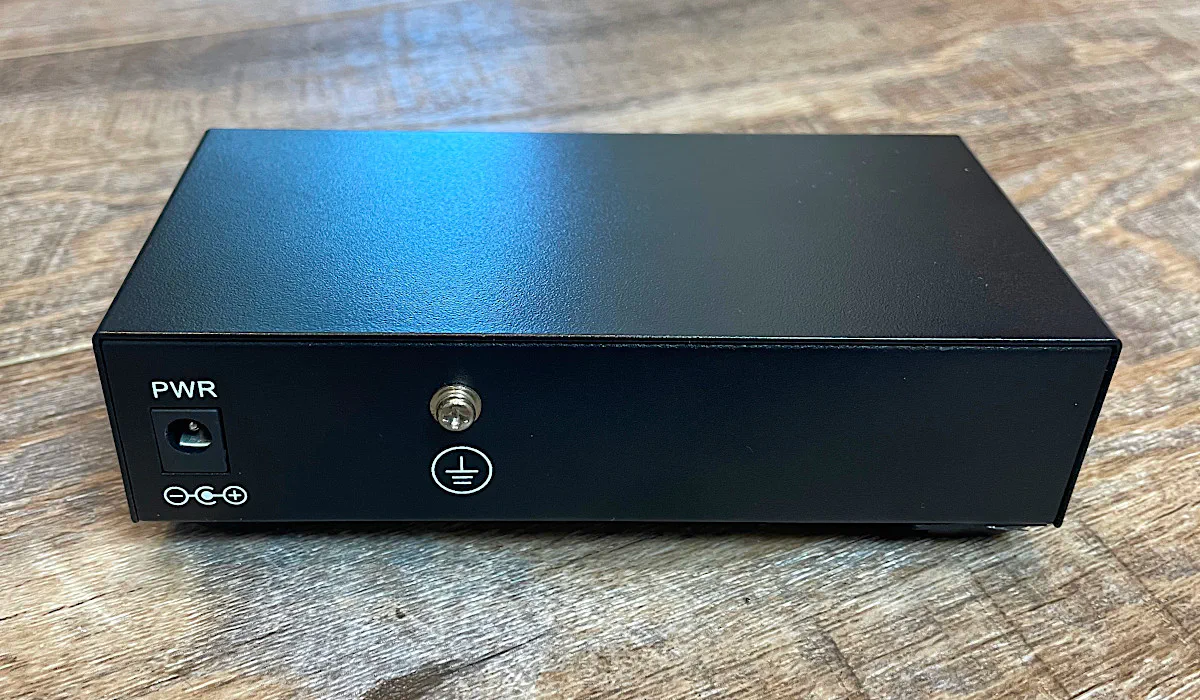
Build Quality
The build quality seems reasonable for the price. The switch is fanless and has a metal chassis with some vents on both sides to help with airflow.
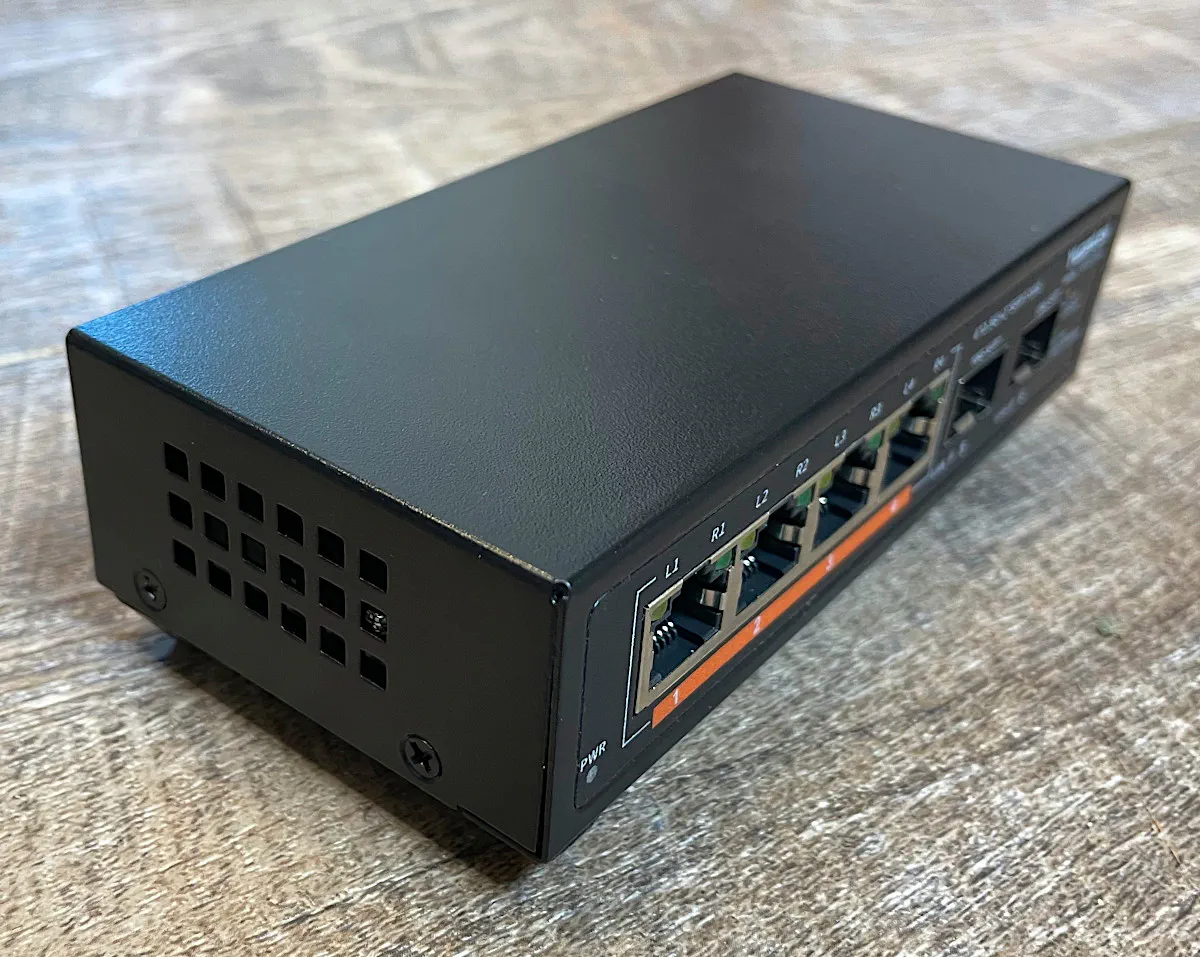
My biggest complaint would be that there are no feet on the bottom of the switch. Since this switch is not designed to be rackmounted, having rubber feed would be great because it will not slide around as much when you are plugging devices into the switch. This is especially true if you are planning to put it on a metal rackmount shelf like me.
I bought some rubber feet off of Amazon (affiliate link) that I could put on the bottom of the switch (I actually needed some rubber feet for some other devices so I am putting the extra ones to good use). I am pleased with how well the feet holds the switch in place. Even though the package of rubber feet came with smaller feet, I actually decided to use the larger feet for better grip as shown below.
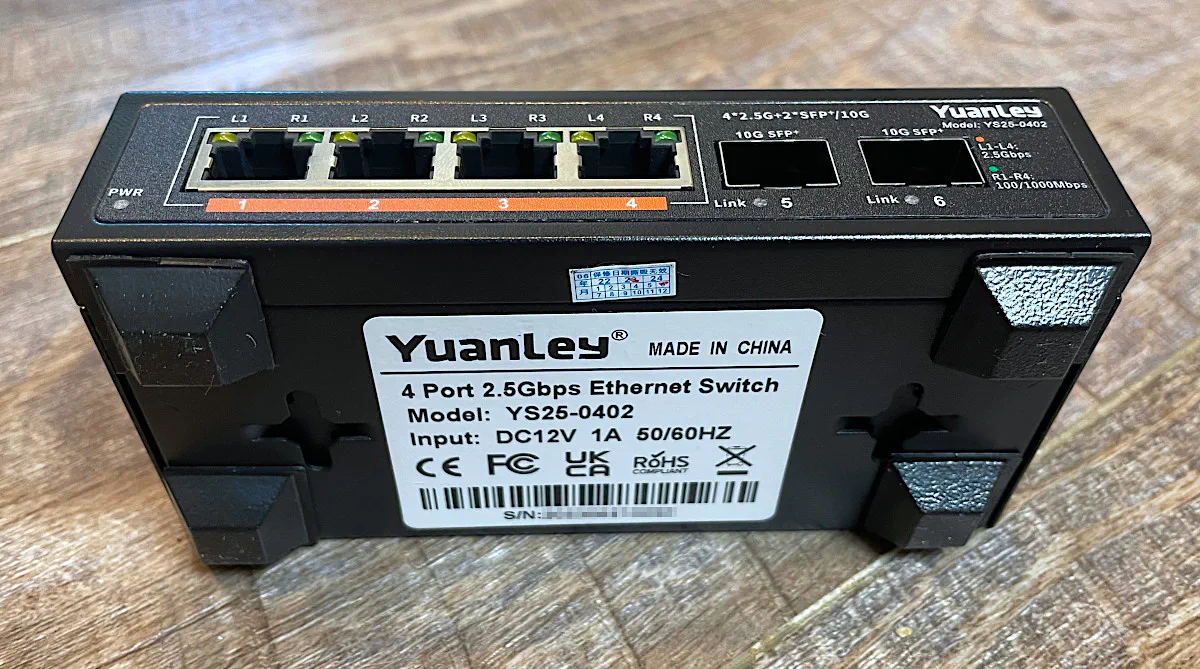
Also note at the bottom of the switch are some holes where you could wall mount the switch if you like wall mounting your networking equipment.
Performance
To verify I was able to get full line speed on the switch, I performed a few iperf3 tests.
First up are the 2.5G Ethernet interfaces. As shown below, I was able to get the full 2.5G line speed (there is a little bit of network overhead which prevents getting the maximum advertised speeds).
[ ID] Interval Transfer Bitrate Retr Cwnd
[ 5] 0.00-10.00 sec 2.74 GBytes 2.36 Gbits/sec 0 714 KBytes
[ 5] 10.00-20.00 sec 2.74 GBytes 2.35 Gbits/sec 0 714 KBytes
[ 5] 20.00-30.00 sec 2.74 GBytes 2.35 Gbits/sec 0 714 KBytes
[ 5] 30.00-40.00 sec 2.74 GBytes 2.35 Gbits/sec 0 714 KBytes
[ 5] 40.00-50.00 sec 2.74 GBytes 2.35 Gbits/sec 0 714 KBytes
[ 5] 50.00-60.00 sec 2.74 GBytes 2.35 Gbits/sec 0 1.07 MBytes
- - - - - - - - - - - - - - - - - - - - - - - - -
[ ID] Interval Transfer Bitrate Retr
[ 5] 0.00-60.00 sec 16.4 GBytes 2.35 Gbits/sec 0 sender
[ 5] 0.00-60.04 sec 16.4 GBytes 2.35 Gbits/sec receiver
Next up are the 10G SFP+ interfaces. This first test is when the MTU is set at the default of 1500. This test was able to obtain 9.3 Gbps.
[ ID] Interval Transfer Bitrate
[ 5] 0.00-10.00 sec 10.9 GBytes 9.35 Gbits/sec
[ 5] 10.00-20.00 sec 10.9 GBytes 9.34 Gbits/sec
[ 5] 20.00-30.00 sec 10.9 GBytes 9.37 Gbits/sec
[ 5] 30.00-40.00 sec 10.9 GBytes 9.38 Gbits/sec
[ 5] 40.00-50.00 sec 10.9 GBytes 9.37 Gbits/sec
[ 5] 50.00-60.00 sec 10.9 GBytes 9.36 Gbits/sec
[ 5] 60.00-60.00 sec 2.07 MBytes 9.40 Gbits/sec
- - - - - - - - - - - - - - - - - - - - - - - - -
[ ID] Interval Transfer Bitrate
[ 5] 0.00-60.00 sec 65.4 GBytes 9.36 Gbits/sec receiver
While 9.3 Gbps is pretty good, if you want max performance on the 10G interfaces you will need to enable jumbo frames by setting the MTU to 9000. You can see in the results below that you gain approximately 500 Mbps by enabling jumbo frames.
Note
Please note that everything on the network must be set to MTU of 9000 for jumbo frames to work properly. Mostly likely you would want to do this on a backend storage network. If you have other devices on your network (on the 2.5G interfaces, for instance), you may not be able to make use of jumbo frames especially since not all devices allow you to change the MTU values.
[ ID] Interval Transfer Bitrate
[ 5] 0.00-10.00 sec 11.5 GBytes 9.85 Gbits/sec
[ 5] 10.00-20.00 sec 11.5 GBytes 9.89 Gbits/sec
[ 5] 20.00-30.00 sec 11.5 GBytes 9.87 Gbits/sec
[ 5] 30.00-40.00 sec 11.5 GBytes 9.88 Gbits/sec
[ 5] 40.00-50.00 sec 11.5 GBytes 9.89 Gbits/sec
[ 5] 50.00-60.00 sec 11.5 GBytes 9.88 Gbits/sec
[ 5] 60.00-60.00 sec 2.14 MBytes 9.99 Gbits/sec
- - - - - - - - - - - - - - - - - - - - - - - - -
[ ID] Interval Transfer Bitrate
[ 5] 0.00-60.00 sec 69.0 GBytes 9.87 Gbits/sec receiver
Power Consumption
The power consumption was measured using a smart plug with energy monitoring. When I plugged in the switch with nothing plugged into the Ethernet or SFP+ ports, the energy consumption was 1.8-2 Watts. With all of the ports populated, it seemed to be hovering around 4.6 Watts.
Temperature
As I do not have a temperature gun to measure the actual temperature, I will say that the switch was barely warm to the touch even after doing some performance testing so there should be no concern of overheating assuming you provide adequate space for the switch. The switch is located in my server closet, which remains a few degrees above room temperature (73-74 degrees Fahrenheit) and did not seem to affect the temperature of the switch.
Where to Purchase?
If you need a basic unmanaged switch with higher speed interfaces, you may be satisfied with the YuanLey switch (and likely any other budget friendly unmanaged switch) since it seems to perform well, does not consume a lot of power, and does not seem to generate a lot of heat (as long as you give it room to breathe, of course).
You can find the YuanLey 2.5/10G switch on Amazon (affiliate link) . I appreciate your support when you use any of my affiliate links! It does not cost you extra, but I get a very small percentage of the sale.
